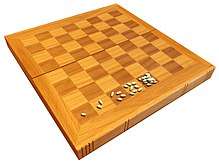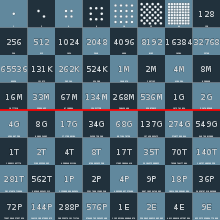Wheat and chessboard problem

The wheat and chessboard problem (sometimes expressed in terms of rice grains) is a mathematical problem expressed in textual form as:
If a chessboard were to have wheat placed upon each square such that one grain were placed on the first square, two on the second, four on the third, and so on (doubling the number of grains on each subsequent square), how many grains of wheat would be on the chessboard at the finish?
The problem may be solved using simple addition. With 64 squares on a chessboard, if the number of grains doubles on successive squares, then the sum of grains on all 64 squares is: 1 + 2 + 4 + 8 + ... and so forth for the 64 squares. The total number of grains equals 18,446,744,073,709,551,615, much higher than most expect.
This exercise can be used to demonstrate how quickly exponential sequences grow, as well as to introduce exponents, zero power, capital-sigma notation and geometric series. Updated for modern times using pennies and the hypothetical question, "Would you rather have a million dollars or the sum of a penny doubled every day for a month?", the formula has been used to explain compounded interest.[1][2]
Origins
The problem appears in different stories about the invention of chess. One of them includes the geometric progression problem. The story is first known to have been recorded in 1256 by Ibn Khallikan.[3] Another version has the inventor of chess (in some tellings Sessa, an ancient Indian Minister) request his ruler give him wheat according to the wheat and chessboard problem. The ruler laughs it off as a meager prize for a brilliant invention, only to have court treasurers report the unexpectedly huge number of wheat grains would outstrip the ruler's resources. Versions differ as to whether the inventor becomes a high-ranking advisor or is executed.[4]
Macdonnell also investigates the earlier development of the theme.[5]
- [According to al-Masudi's early history of India], shatranj, or chess was invented under an Indian king, who expressed his preference for this game over backgammon. [...] The Indians, he adds, also calculated an arithmetical progression with the squares of the chessboard. [...] The early fondness of the Indians for enormous calculations is well known to students of their mathematics, and is exemplified in the writings of the great astronomer Āryabaṭha (born 476 A.D.). [...] An additional argument for the Indian origin of this calculation is supplied by the Arabic name for the square of the chessboard, (بيت, "beit"), 'house'. [...] For this has doubtless a historical connection with its Indian designation koṣṭhāgāra, 'store-house', 'granary' [...].
Solutions
The simple, brute-force solution is just to manually double and add each step of the series:
- where is the total number of grains.
The series may be expressed using exponents:
and, represented with capital-sigma notation as:
It can also be solved much more easily using:
A proof of which is:
Multiply each side by 2:
Subtract original series from each side:
The solution above is a particular case of the sum of a geometric series, given by
where is the first term of the series, is the common ratio and is the number of terms.
In this problem , and .
The exercise of working through this problem may be used to explain and demonstrate exponents and the quick growth of exponential and geometric sequences. It can also be used to illustrate sigma notation. When expressed as exponents, the geometric series is: 20 + 21 + 22 + 23 + ... and so forth, up to 263. The base of each exponentiation, "2", expresses the doubling at each square, while the exponents represent the position of each square (0 for the first square, 1 for the second, etc.).
The number of grains is the 64th Mersenne number.
Second half of the chessboard

In technology strategy, the "second half of the chessboard" is a phrase, coined by Ray Kurzweil,[6] in reference to the point where an exponentially growing factor begins to have a significant economic impact on an organization's overall business strategy. While the number of grains on the first half of the chessboard is large, the amount on the second half is vastly (232 > 4 billion times) larger.
The number of grains of wheat on the first half of the chessboard is 1 + 2 + 4 + 8 + ... + 2,147,483,648, for a total of 4,294,967,295 (232 − 1) grains, or about 279 tonnes of wheat (assuming 65 mg as the mass of one grain of wheat).[7]
The number of grains of wheat on the second half of the chessboard is 232 + 233 + 234 + ... + 263, for a total of 264 − 232 grains. This is equal to the square of the number of grains on the first half of the board, plus itself. The first square of the second half alone contains more grains than the entire first half. On the 64th square of the chessboard alone there would be 263 = 9,223,372,036,854,775,808 grains, more than two billion times as many as on the first half of the chessboard.
On the entire chessboard there would be 264 − 1 = 18,446,744,073,709,551,615 grains of wheat, weighing about 1,199,000,000,000 metric tons. This is about 1,645 times the global production of wheat in 2014 (729,000,000 metric tons).[8]
Use
Carl Sagan titled the second chapter of his final book The Persian Chessboard and wrote that when referring to bacteria, "Exponentials can't go on forever, because they will gobble up everything."[9] Similarly, The Limits to Growth uses the story to present suggested consequences of exponential growth: "Exponential growth never can go on very long in a finite space with finite resources."[10]
See also
References
- ↑ "A Penny Doubled Every Day for 30 Days = $10.7M" – via www.bloomberg.com.
- ↑ "Doubling Pennies". Mathforum.org. Retrieved 2017-08-09.
- ↑ Clifford A. Pickover (2009), The Math Book: From Pythagoras to the 57th Dimension, New York : Sterling. ISBN 9781402757969. p. 102
- ↑ Tahan, Malba (1993). The Man Who Counted: A Collection of Mathematical Adventures. New York: W.W. Norton & Co. pp. 113–115. ISBN 0393309347. Retrieved 2015-04-05.
- ↑ Macdonell, A. A. (2011-03-15). "Art. XIII.—The Origin and Early History of Chess". Journal of the Royal Asiatic Society of Great Britain & Ireland. 30 (01): 117–141. doi:10.1017/S0035869X00146246. Retrieved 2015-04-05.
- ↑ Kurzweil, Ray (1999). The Age of Spiritual Machines: When Computers Exceed Human Intelligence. New York: Penguin. p. 37. ISBN 0-670-88217-8. Retrieved 2015-04-06.
- ↑ "Encyclopedia Britannica: Grain, unit of weight". 29 April 2004. Retrieved 2 March 2017.
- ↑ "FAOSTAT". faostat3.fao.org. Retrieved 2 March 2017.
- ↑ Sagan, Carl (1997). Billions and Billions: Thoughts On Life And Death At the Brink Of The Millennium. New York: Ballantine Books. p. 17. ISBN 0-345-37918-7.
- ↑ Meadows, Donella H., Dennis L. Meadows, Jørgen Randers, and William W. Behrens III (1972). The Limits to Growth, p. 21, at Google Books. New York: University Books. ISBN 0-87663-165-0. Retrieved 2015-04-05.
External links
- Weisstein, Eric W. "Wheat and Chessboard Problem". MathWorld.
- One telling of the fable
- Salt and chessboard problem - A variation on the wheat and chessboard problem with measurements of each square.